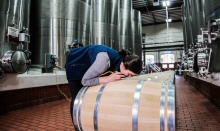|
 The long days of the harvest are over. Primary fermentation of the year's grapes is over and by now wines are being stored in steel tanks or wood barrels. The vines are dormant in the vineyard with the settling in of colder weather. It must be quiet in wineries this time of year in winter, right? Not really. The long days of the harvest are over. Primary fermentation of the year's grapes is over and by now wines are being stored in steel tanks or wood barrels. The vines are dormant in the vineyard with the settling in of colder weather. It must be quiet in wineries this time of year in winter, right? Not really.
Although this is certainly not the busiest time of year for the wine making process, and wineries will cut back significantly on staff during this time, there are still crucial tasks which need to be conducted. Often you'll hear that the first great ingredient in wine is to have great grapes. While this is undoubtedly true, another critical ingredient to quality is attention to detail. And it's during the slower winter season when detail oriented tasks play a key role for winemakers and cellar hands.
While the busy time of getting grapes harvested and wines through the initial fermentation stage is over, essentially turning the grapes into wine by starting alcohol fermentation, the new wines cannot be pushed aside and forgotten until the time for bottling. While in oak barrels or tanks, sediment from the wines drops to the bottom of the aging vessels. The tiny chemical changes occurring in the wines need to be monitored and there's an often overlooked task called "topping up" which is essential during this time.
Topping up is not the most glamorous task in a winery, but it is an essential one and one that has to happen continually at this time of year for any wine in oak barrels. Topping up is pretty much how it sounds - barrels are filled by pitcher-wielding cellar hands to account for evaporation that occurs. This loss of small amounts of wine is affectionately known as the Angel's Share of the wines.
 Oak is porous, so small amounts of wine evaporate through the barrel staves, replaced by miniscule amounts of air. This introduction of oxygen through the oak into the wines is responsible for the imparting of specific flavors in wines, such as vanilla and tobacco. Red wines in oak also absorb tannins from the wood. While the introduction of small amounts of oxygen is viewed as a beneficial component of the winemaking process, too much evaporation in the barrels could have devastating effects on the wine. This is where topping up comes into play. Oak is porous, so small amounts of wine evaporate through the barrel staves, replaced by miniscule amounts of air. This introduction of oxygen through the oak into the wines is responsible for the imparting of specific flavors in wines, such as vanilla and tobacco. Red wines in oak also absorb tannins from the wood. While the introduction of small amounts of oxygen is viewed as a beneficial component of the winemaking process, too much evaporation in the barrels could have devastating effects on the wine. This is where topping up comes into play.
The actual wine juice used for topping off is typically not the highest quality and is often a field blend of various varietals. But the percentage of this added wine in the barrels is not enough to substantially contribute to the overall character of the wine in the barrel. Another task often conducted during this time is the "racking" of red wines. This is done by pumping from one barrel to another, briefly adding more oxygen to the wines and also discarding the fallen sediment, including lees (dead yeast cells). How about in the vineyards themselves? Although the vines are essentially dormant at this time, vineyard managers are not completely idle. Many will plant, spread, and maintain cover crops between their vines. Typical cover crops used are mustard, clover, and various beans. Cover crops are used for various reasons.
They may be planted on the hillside slopes of vineyards to help prevent and control erosion. They may be mowed and mulched to use as a source of nitrogen to enrich soils. Or they may actually be planted to compete for water with surrounding vines in an attempt to de-vigorize overly prolific vines.
 Back at the winery, there are still other requirements often addressed during this time of year. Sometimes it may be difficult to picture, but wineries are businesses like any other, and administrative tasks are not forgiven. Just as much as anywhere else, wineries need to stay on top of their business affairs. These affairs also include winery specific requirements, such as reporting to various regulatory entities on their operations. Back at the winery, there are still other requirements often addressed during this time of year. Sometimes it may be difficult to picture, but wineries are businesses like any other, and administrative tasks are not forgiven. Just as much as anywhere else, wineries need to stay on top of their business affairs. These affairs also include winery specific requirements, such as reporting to various regulatory entities on their operations.
And so, despite initial appearances, winter is not a time of total leisure in the wine- making business. Whether in the vineyards or in the cellar rooms, there are always tasks to be done contributing to the overall end goal of a creating a great bottle of wine.
|